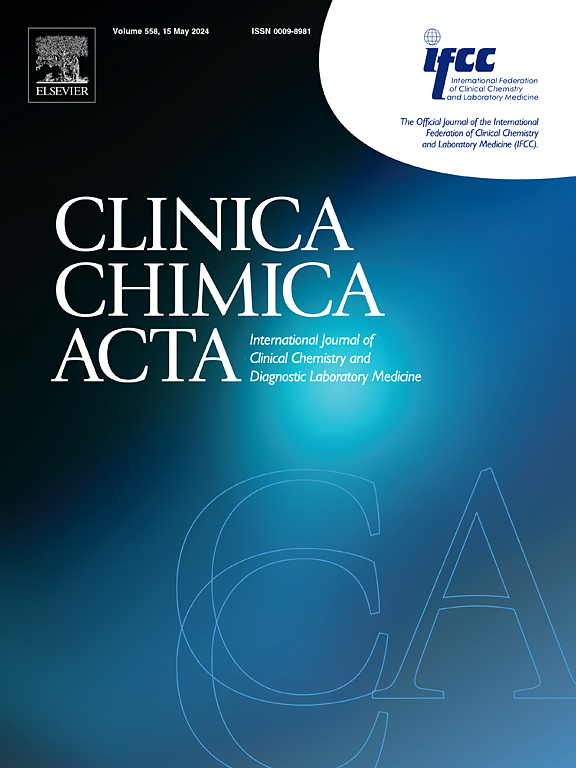亚洲人的良性前列腺增生基因变异。
IF 3.2
3区 医学
Q2 MEDICAL LABORATORY TECHNOLOGY
引用次数: 0
摘要
良性前列腺增生症(BPH)在全球的发病率逐年上升,亚洲人的发病率尤其高。良性前列腺增生症会使前列腺癌的发病风险增加 2 到 12 倍,因此迫切需要全面的临床指南和适当的风险分层检测。本综述首次针对这一空白,重点介绍了对亚洲人进行风险分层的基因筛查,随后根据所发现的基因变异发展了病理生理学。例如,CYP17 基因在睾酮合成和良性前列腺增生症进展中起着至关重要的作用,其中包括 CYP17 rs743572 C 等位基因,这种基因变异会使亚洲人患良性前列腺增生症的风险增加 1.58 倍。识别这种基因变异可以根据个体的基因特征调整治疗方法。此外,这篇综述还对良性前列腺增生症的病理生理学提出了新的见解,表明种族可能在其发展过程中起到一定的作用,并探讨了良性前列腺增生症与传统上被认为是良性前列腺增生症危险因素的其他疾病之间的遗传联系。本文章由计算机程序翻译,如有差异,请以英文原文为准。
Benign prostatic hyperplasia genetic variants in Asians
The global prevalence of benign prostatic hyperplasia (BPH) is increasing annually, with a notably higher incidence in Asian populations. This condition can increase the risk of developing prostate cancer 2- to 12-fold, underscoring the critical need for comprehensive clinical guidelines and appropriate risk stratification testing. This review is the first to address the gap by focusing on genetic screening for risk stratification in Asians, followed by the development of pathophysiology based on the genetic variants identified. For example, the CYP17 gene, which plays a crucial role in testosterone synthesis and BPH progression, includes the CYP17 rs743572 C allele, a genetic variant that increases the risk of BPH by 1.58 times in Asians. Identifying such genetic variants can enable the tailoring of therapies to individual genetic profiles. Furthermore, this review provides new insights into the pathophysiology of BPH, suggesting that ethnicity may play a role in its progression, and explores genetic links between BPH and other diseases traditionally considered risk factors for BPH.
求助全文
通过发布文献求助,成功后即可免费获取论文全文。
去求助
来源期刊

Clinica Chimica Acta
医学-医学实验技术
CiteScore
10.10
自引率
2.00%
发文量
1268
审稿时长
23 days
期刊介绍:
The Official Journal of the International Federation of Clinical Chemistry and Laboratory Medicine (IFCC)
Clinica Chimica Acta is a high-quality journal which publishes original Research Communications in the field of clinical chemistry and laboratory medicine, defined as the diagnostic application of chemistry, biochemistry, immunochemistry, biochemical aspects of hematology, toxicology, and molecular biology to the study of human disease in body fluids and cells.
The objective of the journal is to publish novel information leading to a better understanding of biological mechanisms of human diseases, their prevention, diagnosis, and patient management. Reports of an applied clinical character are also welcome. Papers concerned with normal metabolic processes or with constituents of normal cells or body fluids, such as reports of experimental or clinical studies in animals, are only considered when they are clearly and directly relevant to human disease. Evaluation of commercial products have a low priority for publication, unless they are novel or represent a technological breakthrough. Studies dealing with effects of drugs and natural products and studies dealing with the redox status in various diseases are not within the journal''s scope. Development and evaluation of novel analytical methodologies where applicable to diagnostic clinical chemistry and laboratory medicine, including point-of-care testing, and topics on laboratory management and informatics will also be considered. Studies focused on emerging diagnostic technologies and (big) data analysis procedures including digitalization, mobile Health, and artificial Intelligence applied to Laboratory Medicine are also of interest.
 求助内容:
求助内容: 应助结果提醒方式:
应助结果提醒方式:


